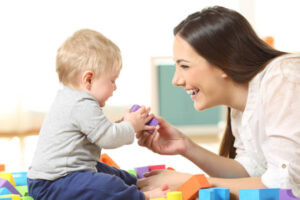
“The initial evaluation team recommended developmental therapy for my child but my concerns are with her speech. How can developmental therapy help support her speech? I thought that it focused on preschool readiness skills?” — Concerned Parent
Developmental therapy (DT) focuses on the whole child and often addresses different areas of development, including speech and communication. DT can often be used to complement and support speech therapy by helping your child learn pre-communication skills. These skills include sharing joint attention, attention span, imitation of gestures and play ideas, and general play skills and are essential in learning how to speak! This blog will explain these skills and how you as a parent can help your child with their pre-communication skills.
Pre-communication skills
Joint attention: Joint attention is when two people share attention with an object or activity. This can be demonstrated by sharing eye contact, using gestures, and/or other non-verbal and verbal communication. While children can learn some skills from toys and objects independently, they absolutely need to be able to share joint attention with another person to learn language and how to communicate with others.
Attention span: In order to learn any new skill, one must have the attention span to attend to an activity. On average, a child is expected to attend to a single activity for – at minimum – one to one-and-a-half minutes per year of age. And as they age, a child should be able to attend to several activities in a row.
Imitation of gestures: Imitation of gestures always comes before imitation of words. It is important for your child to learn that they can imitate what other people are doing! Once your child is consistently imitating familiar gestures (such as waving or clapping), novel or play gestures (feeding the baby a bottle, for example), and “invisible” gestures (this is a gesture that you can do but not see yourself do, such as sticking out your tongue or tugging your ear), we know that your child is on track to using sounds and words to communicate.
Play skills: A child’s “work” is play! It is important for your child to engage in functional play with toys to learn the concept the toys are targeting. Engaging in functional play provides your child opportunities to use language to communicate. Play is also a great measure of a child’s cognition!
How can parents support pre-communication skills?
Joint attention: Engage in a preferred activity that your child has mastered – we want to make sure they can focus on learning the skill of joint attention and not forcing too many cognitive demands at once. For example, if your child does not yet match, you would not use a puzzle for this activity. Activities with lower cognitive demands – such as popping bubbles – is much more appropriate for a joint attention activity (but if your child has mastered matching, feel free to use a puzzle!) After blowing bubbles a few times for your child, pause the activity. Give him or her the opportunity to come to you and show you that they want “more” by using eye contact or gesturing to you what they want. If they only look at or touch the bubbles, bring the bubbles near your face to encourage eye contact. Once they look to you, provide praise and blow more bubbles! Continue this routine as long as your child will tolerate.
Attention span: Toddlers are notorious for having a decreased attention span! Everything is so new and interesting to them, no wonder they want to bop around the room and get into everything! Make sure you create a learning and play space that is conducive to attending to activities. Having a large number of toys available at all times or always having the television can create many distractions for your child.
When starting to work on increasing your child’s attention span, your goal should be to complete one activity – that’s it! An activity with a clear beginning and end, such as a puzzle or book, are great activities to start with. Engaging in symbolic play with a baby doll, for example, would be considered an open-ended activity that can be finished after one minute or ten. And again, you want to choose something that they have mastered so they are not expected to complete an activity that is new or particularly challenging.
Imitation: To work on a child’s imitation skills, you can start by imitating them! If they bang a toy on their highchair, you do the same. Encourage your child to do the gesture again before imitating it again. Once you go back and forth a few times, change the gesture – rub an object on the highchair instead for example. If your child does not imitate this gesture, do it again. If they continue to not imitate this gesture, provide hand over hand assistance to show them exactly how to imitate this gesture.
Play skills: Sometimes, children need to be taught how to play functionally with objects! Just like any other skill, play needs to supported and taught and it is up to the child’s first teacher – their parents – to show them just that. Parents should be modeling appropriate play with toys and encouraging the child to do the same (this is also where those imitation skills come in handy!) Help your child master functional play by setting aside a few minutes every day to provide your child your undivided attention and PLAY!
Questions or concerns?
If you have questions or concerns about your child’s pre-communication skills, please contact us at info@playworkschicago.com or 773-332-9439.
Kimberly Shlaes, MAT, DT
Director of Developmental Therapy Services
Reference:
Teach Me to Talk. (July 30, 2018). Sorting Out the 11 Prelinguistic Skills… Retrieved April 25, 2019 from http://teachmetotalk.com/2018/07/30/sorting-out-the-11-prelinguistic-skills/
Photo Credit: PublicDomainPictures from Pixabay





